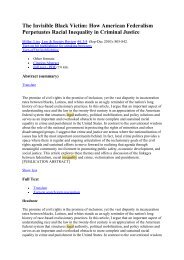Foreign Investment Strategies and Sub-national ... - E-Journal
Foreign Investment Strategies and Sub-national ... - E-Journal
Foreign Investment Strategies and Sub-national ... - E-Journal
You also want an ePaper? Increase the reach of your titles
YUMPU automatically turns print PDFs into web optimized ePapers that Google loves.
2.2. Institutional Change during Economic Transition<br />
A major challenge for foreign investors in emerging economies is the rapid change of institutions. In<br />
transition economies, reforms initially concern primarily formal institutions at the central level (World Bank<br />
1996). When the regulatory framework is changed at the centre, this directly affects formal institutions at the<br />
sub-<strong>national</strong> level. However, the impact on informal institutions occurs only with considerable delays (North<br />
1990). Firms may thus react with considerable inertia <strong>and</strong> gradually move from network-based strategies to<br />
market-based ones (Khanna <strong>and</strong> Palepu 2000, Peng 2003). In fact, Peng <strong>and</strong> Heath (1996) argue that during<br />
periods of institutional change, informal institutions become more important as old coordination mechanisms<br />
are no longer operational, but new coordination mechanism are not yet fully established. The mechanisms by<br />
which these changes of informal institutions influence businesses are not well understood (Hoskisson et al.<br />
2000).<br />
Vietnam is such a transition economy with “a bureaucratic, yet entrepreneurial, business<br />
environment” (von Glinow <strong>and</strong> Clarke 1995). Vietnam began a gradual path of reform in 1986 following the<br />
Chinese example of gradualism. However, the communist party still remains firmly in power, <strong>and</strong> many<br />
aspects of the economy are subject to regulation or direct interference by the authorities of the government or<br />
ruling party. Even Prime Minister Phan Van Khai acknowledges, “Our administrative procedures are still<br />
cumbersome. You can get approval at the central level, but you still have problems at the local level with<br />
issues like l<strong>and</strong>” (Phan 2003).<br />
State-owned enterprises (SOEs) still contribute more than the domestic private sector to GDP, but<br />
their share has been gradually declining from 40.5% in 1997 to 38.3% in 2002 (Nguyen et al. 2004).<br />
Government policy aims to restructure SOEs, by “equitisation” (a synonym for privatisation), reduction of<br />
subsidies, <strong>and</strong> restructuring of non-performing loans. Historically, private businesses were subject to<br />
substantial discretionary interference by governmental authorities. In 1999, policy changed towards<br />
supporting entrepreneurship <strong>and</strong> the development of private enterprises, but their growth continues to be<br />
inhibited by an institutional framework favouring SOEs (Tenev et al. 2003).<br />
9














